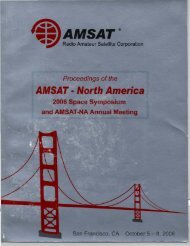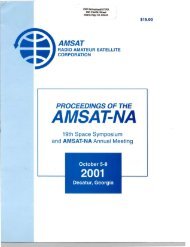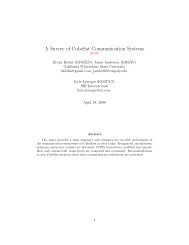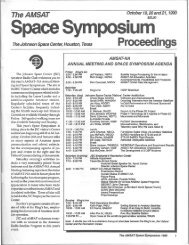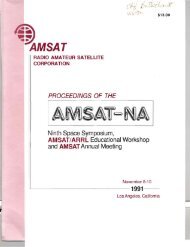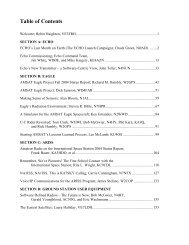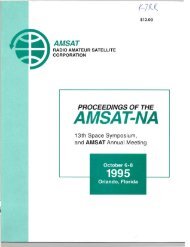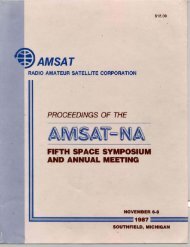October 27-29, 2000 - Klofas.com
October 27-29, 2000 - Klofas.com
October 27-29, 2000 - Klofas.com
You also want an ePaper? Increase the reach of your titles
YUMPU automatically turns print PDFs into web optimized ePapers that Google loves.
use, the feed characteristics must be matched to the dish. A significant detennining factor<br />
is to use whatever you can get!<br />
Another aspect ofparabolic dish use is the diameter of the dish itself. The gain of<br />
a dish antenna is related to the diameter ofthe dish. This is all fine until one realizes that<br />
while higher gain means more signal strength, it also means narrower receiving<br />
beamwidth. For moonbounce service, a huge dish is fine, because the moon doesn't move<br />
very fast. But satellites are rather speedy. The larger the dish, the more difficult it will be<br />
to keep it pointed where you want it. Generally, the smallest dish that will give<br />
satisfactory signal strength is the most desirable.<br />
Phase 3D signals will be right-hand circularly polarized. Ideally, your antenna<br />
should also be circularly polarized. The desired hand ofreceived antenna circularity is<br />
right hand. Since the dish itself is only a reflector, bouncing a signal off it reverses the<br />
hand. Therefore, the dish feed itself must be left hand. Practically, it is much easier to<br />
fabricate a linearly-polarized feed. The perfonnance penalty for linear versus circular is 3<br />
dB, a reasonable tradeoff to mechanical<br />
<strong>com</strong>plexity. Linear dish feeds usually take the<br />
fonn of a coax connector with probe in a short<br />
piece ofWR90 (.9" x .45") waveguide,<br />
frequently with a small hom on the end to<br />
accurately control the beamwidth. The feed<br />
shown is suitable for use in a .4 to .5 fld dish.<br />
A 10GHz preamp is attached.<br />
Preamps<br />
All receiving systems for the bands 70 cm and higher require special attention to<br />
minimizing noise figure. This nonnally requires an antenna-mounted RF preamplifier,<br />
though some converters are designed to be mounted directly at the antenna feed. It is<br />
probably best to purchase a built-and-tested preamp from Down East or SSB. Down East<br />
also has kits available for W5LUA-designed preamps that should do quite nicely. The<br />
problem with any preamp kit is that it may not function optimally as built. "Tweaking"<br />
for best noise figure is usually required.<br />
Whatever preamp you use, the preferred mounting is right on the dish feed itself.<br />
However, some preamps may be so large that they are physically difficult to mount or<br />
may actually shadow a significant area ofthe dish. Just mount them as close as possible<br />
and use good line and connectors between the feed and the preamp. SMA connectors and<br />
UT -141 miniature copper hardline are preferred over N connectors and coax, though both<br />
will work.<br />
Preamps are rated by noise figure and gain, both specified in dB. The preamp<br />
noise figure sets the weak signal perfonnance for the entire system. On 10 GHz, a<br />
satisfactory noise figure is less than 2 dB. Gain is somewhat less important, with 10 dB<br />
being about nonnal for a single-stage device, assuming that the actual converter itself has<br />
20-30 dB ofgain. If you are feeding a converter mounted fairly close to the preamp, this<br />
is all that is required. If, for some reason, you want to drive a really long (and lossy) piece<br />
ofcoax to the converter, a higher gain preamp may be required. Ifyour converter itself a<br />
good noise figure, mount it as close to the feed as possible and dispense with the preamp.<br />
41



